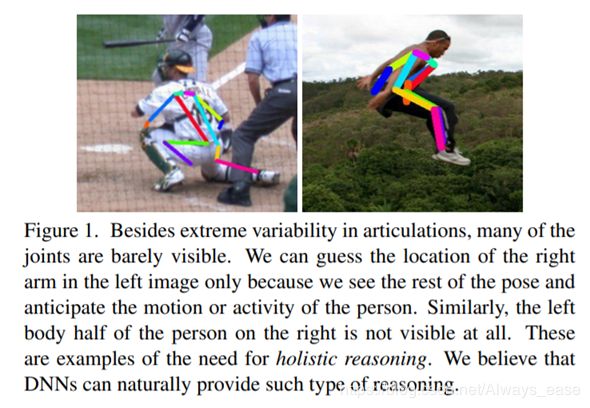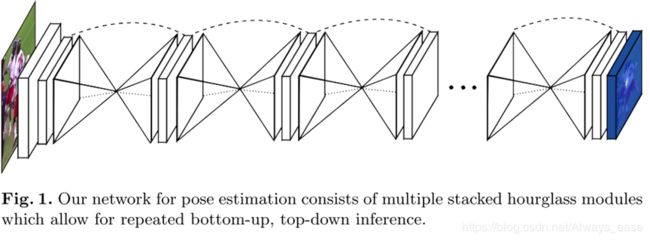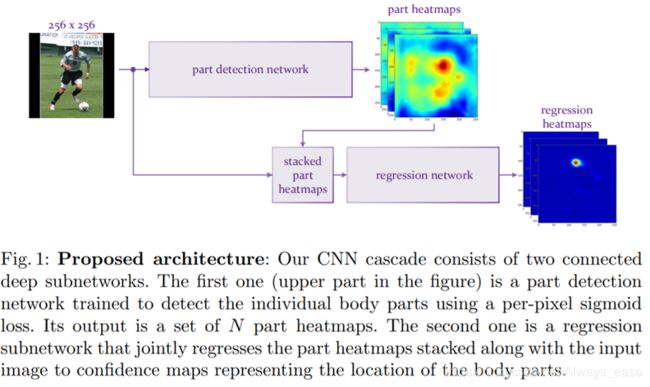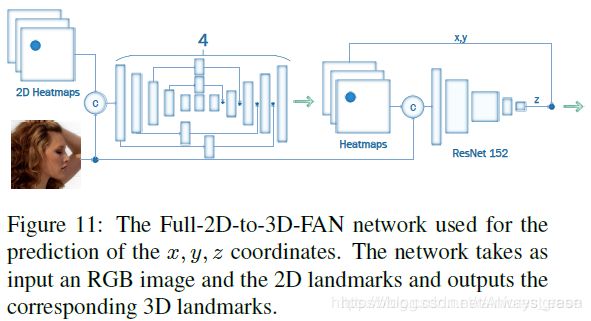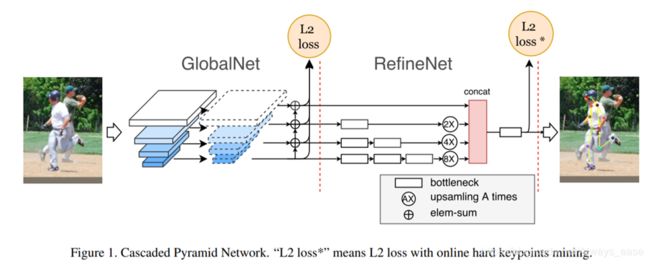【系列论文研读】Pose Estimation
Human Pose Estimation
一、Definition:
- defined as the problem of localization of human joints
- challenges of this problem – strong articulations, small and barely visible joints
二、Two methods:
- Top-down:Locate Person -> Locate Joints
- Bottom-up: Locate All Joints -> which person
Paper
一、DeepPose(cvpr2014)
Title:DeepPose: Human Pose Estimation via Deep Neural Networks
Author:Alexander Toshev, Christian Szegedy (Google)
Main contributions:
1、formulate the pose estimation as a joint regression problem
Using the entire image as input for each joint.
2、propose a cascade of DNN-based pose predictors
Method:
Normalize the joint coordinates to a box bounding the human body or parts of it:![]()
Image: (x,N(yi,b))
Network architecture
1. estimating an initial pose as outlined in the previous section
2. additional DNN regressors are trained to predict a displacement of the joint locations from previous stage to the true location.
二、Stacked Hourglass Networks (ECCV2016)
Title:Stacked Hourglass Networks for Human Pose Estimation
Author: Alejandro Newell, Kaiyu Yang, and Jia Deng (University of Michigan)
Key idea:
1.The network captures and consolidates information across all scales of the image.
2.pools down to a very low resolution, then upsamples and combines features across multiple resolutions
3.consecutively placing multiple hourglass modules together end-to-end
Network architecture:
1、Residual Module
All convolutional layers have stride=1, padding=1, no change of data size, and only changes the depth.
2、HG
- The symmetric topology of these networks is similar
- simple nearest neighbor upsampling
- outputs a collection of heatmaps
3、Total network with intermediate supervision
三、Convolutional Part Heatmap Regression(ECCV2016)
Title:Human pose estimation via Convolutional Part Heatmap Regression
Author:Adrian Bulat and Georgios Tzimiropoulos (University of Nottingham)
Key idea: Can effectively handle occlusion
 Loss = pixelwise + cross entropy loss
Loss = pixelwise + cross entropy loss
四、FAN(ICCV2017)
Title:How far are we from solving the 2D & 3D Face Alignment problem?
Author:Adrian Bulat and Georgios Tzimiropoulos (University of Nottingham)
1、2D FAN
2、2D to 3D FAN
1.the input RGB channels have been augmented with 68 additional channels, one for each 2D landmark
2.3D annotations are actually the 2D projections of the 3D coordinates
五、CPN(CVPR2018)
Title:Cascaded Pyramid Network for Multi-Person Pose Estimation
Author:Yilun Chen∗ Zhicheng Wang∗ Yuxiang Peng1 Zhiqiang Zhang2 Gang Yu Jian Sun
Institution: Face++
Performance:COCO 17 Key point detection champion
Problem:hard keypoint detection
Key idea: two stages: GlobalNet and RefineNet; Pyramid
Network:
1. 把人体的关节点,大致分类两类:简单的部分和难的部分。用不同的方案去解决简单点和难点,先解决容易点,再解决难点。在解决难关节点部分时,提供更多的上下文信息,更大的可感受野。
2. 动态地将loss值比较大的几个channels进行反向学习;个人理解是RefineNet Loss更加关注loss值比较大的点,而这些点往往就是hard keypoint;
3、GlobalNet:Resnet50(cov2~5)——Pyramid
4、Upsample before elem-sum
5、L2loss:heatmap;L2loss*: online hard mining, which only BP some channels for hard points
六、Fast Human Pose Estimation(cvpr2019)
Title:Fast Human Pose Estimation
Author: Feng Zhang(1) Xiatian Zhu(2) Mao Ye(1)
1. University of Electronic Science and Technology of China
2. Vision Semantics Limited
